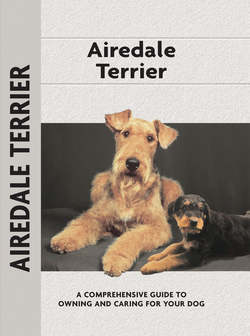Читать книгу Airedale Terrier - Bardi McLennan - Страница 8
На сайте Литреса книга снята с продажи.
ENTER THE SHOW DOG
ОглавлениеThe first dog shows moved from pubs and parlors to become part of the popular agricultural shows. In the mid-1860s, this new breed caught on at shows in nearby Otley, Shipley, Keighly and Bingley first as Waterside Terriers, then as Bingley Terriers. Indeed, the first presentations in Otley and Bingley brought a crowd of admiring spectators to ringside and the public’s acclaim of the breed has not wavered since.
MILI-TERRIERS
In World War I, Germany already had some 50,000 dogs trained for military duty when the war broke out. England hastily recruited and trained 2,000 dogs, including Airedale Terriers, for work at the front with the troops. Dogs that failed the intense training were honorably discharged (sent home). American forces did not have dogs in the military then, but they did by WWII. To prove the worth of these war dogs, Hitler had an estimated 30,000 German Shepherd Dogs ready for action by the outbreak of WWII and Russia topped all nations with a canine military force estimated at 40 to 50,000.
The famous painting “The Airedale,” rendered by the skilled canine artist Mrs. Scott-Langley in 1933, is typical of the good quality Airedales of the period.
In 1882, Hugh Dalziel, a well-known judge and dog writer, chaired a meeting of the Dales terriermen at the Airedale Agricultural Society Show held at Bingley. It was finally decided to settle the name debate and the suggestion of “Airedale Terrier” was agreed upon to represent the entire area rather than a single town.
The breed was entered as the Airedale Terrier in the National Dog Show at Birmingham in 1883 and three years later was officially accepted in the English Kennel Club’s Stud Book. One still had to remain alert in tracing a dog’s lineage, because the names of the dogs changed as often as did the owners. In those days, there were no restrictions regarding a dog’s name or the owner’s kennel affix.
There is inevitably one person in any given breed who stands out as what today would be called the breed’s first publicist, one whose writing ability and contagious enthusiasm for the breed make the world sit up and take notice. In the history of the Airedale Terrier, Holland Buckley of Burnham, Buckinghamshire was that person. Mr. Buckley wrote The Airedale Terrier, the first book dedicated solely to the breed and its early history. He writes of the confusion that existed in many breeds due to the lack of breeding records.
POETIC PRAISE
A poem in praise of the Airedale’s exploits in WWI was written by William Wilson, an Airedale breeder. It ends with the following lines:
“What more can we say of our gallant breed.He answered the call of his country’s need.He did all that was asked and did it well.Then returned home victorious, our brave Airedale.The Airedale was trained by a man of fame.Lieutenant Colonel Richardson was his name.He knew the dangers and hardships, too.But he knew our breed would pull us through.”
The picture below shows the famed Lt. Col. Richardson, teaching an Airedale to climb a ladder to attack an opponent.
In the latter half of the 1800s, when dog shows were still in their infancy, breed classifications were not necessarily specific. The Broken-haired Terrier class, for example, took in just about anything that would visually fit that description. Pedigrees were often non-existent or imprecise: “Ben, sired by Green’s Jim out of Nan” would leave anyone save a close friend of Mr. Green’s completely in the dark as to the lineage. Mr. Buckley tells of one dog having been awarded prizes as an Old English Black and Tan Terrier and as a Welsh Terrier although both parents were known to be Airedales, something not at all uncommon at the time.
By now the breed was definitely all terrier, but at 35–45 pounds (15.9–20.44 kg), it was well beyond the size to “go to earth,” or terra firma, for which all “terriers” are named. The larger size, however, proved to have definite benefits. Longer legs meant the dogs could work in water along the riverbanks without having to swim, while their strong deep chests enabled them to swim a fair distance when necessary. In the fields, longer legs allowed the dogs to clamber over stiles and other obstacles without having to be picked up and carried.
Still, both the size and the terrier designation were disputed. Some felt the dogs should be considered hounds or (horrors!) crossbreeds. Initially, as one would expect, in any given litter some pups might display hound features, and others those of the terrier, lending credence to the crossbreed stand. Of course the Airedale was a mix, but almost every breed of dog in the world that was developed by man for a specific purpose began life as a crossbreed.
“Pioneer of the Airedale Terrier,” as this old woodcut was titled, depicts Young Tanner from the 1880s, typical of how the early Airedale Terriers appeared.
